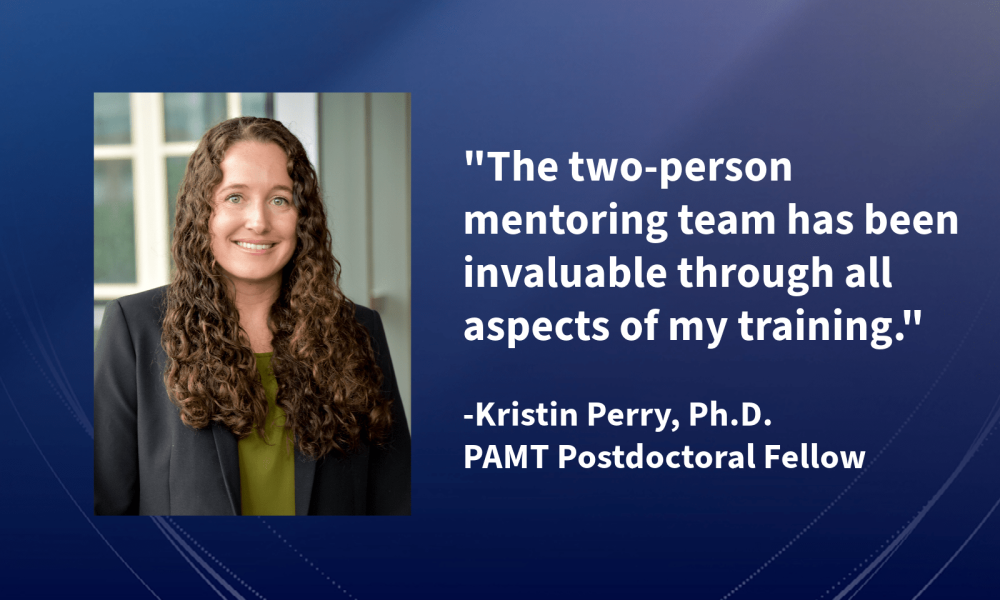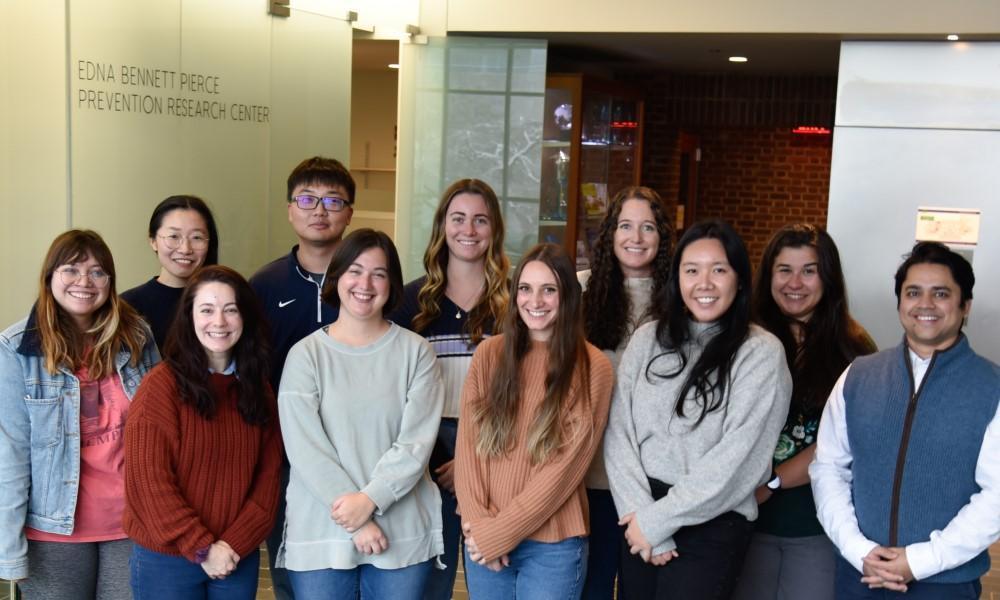Perspectives on PAMT: Kristin Perry
Q & A with Kristin Perry, Ph.D., PAMT Postdoctoral Fellow

Perspectives on PAMT header template-1-Kristin Perry
August 29, 2023
For our ‘Perspectives on PAMT’ series, we asked current Fellows in our Prevention and Methodology Training Program, which is funded through a T32 training grant from the National Institute on Drug Abuse, to reflect on their experiences thus far in the program.
What is the focus of your research? How has it evolved during your time with PAMT?
My research is focused on how prenatal substance exposure and related risks influence underlying stress physiology, which is associated with maladaptive relationship and behavioral outcomes as children enter the preschool years. During my time in PAMT, I have become more interested in examining protective pathways in addition to risky pathways for children who have been exposed to substances prenatally. Additionally, I have become more interested in prevention research addressing caregiver substance use.
What motivated you to apply to PAMT?
When deciding what type of postdoc I was interested in, I wanted to gain more experience with innovative methods, learn about child development during the perinatal period, and incorporate caregiver substance use into my research. Prior to PAMT I had not received intensive training in substance use research but I knew I wanted to learn more about the literature and methods surrounding substance use because it is such an important factor for prevention of child maladjustment. PAMT has allowed me to gain expertise in these domains through collaborations with my two-person mentoring team and the formal and informal training experiences offered through PAMT.
How has PAMT helped you?
PAMT has increased my skills in a number of ways. First, my training experiences in PAMT have expanded my knowledge and interest in the substance use prevention. Specifically, my initial interests were in prenatal substance exposure and have broadened to substance use among fathers and the relationship between parents as a prevention context for child behavior problems.
The training in innovative methods has greatly increased my ability to answer complex developmental questions in novel ways. Specifically, these methods have allowed me to account for dyad-level influences, heterogeneity in children’s pathways, and more precise timing of certain associations.
PAMT has formal training opportunities through didactics and coursework and informal opportunities through collaborations with your mentors. During my time in PAMT, I have taken a course on Time Varying Effect Modeling, a workshop on Latent Class Analysis, and am working on publications using these methods.
I have received extensive training in grant writing and submitted an NIH Loan Repayment Program Award and an R03 grant in the first year of my postdoctoral fellowship. The grant writing bootcamp in the spring was particularly helpful to facilitate my grant writing skills. Finally, the training resources offered through PAMT have allowed me to attend statistical workshops and conferences that have facilitated networking opportunities in addition to learning.
Did you benefit from having a two-person mentoring team, rather than doing a postdoc with a single mentor? If so, how?
The two-person mentoring team has been invaluable through all aspects of my training. My mentors offer unique perspectives on my publications and grants given that they come from different backgrounds. Additionally, they have both offered me invaluable professional development advice that has been instrumental in preparing me for the job market.
What are your career goals?
My career goal is to become an NIH-funded, tenure-track professor at an R1 institute. I am excited to run my own independent lab and mentor trainees.
What advice would you give someone who is thinking about applying to PAMT?
There are so many rich opportunities available through PAMT, so it’s important to have a thorough understanding of your postdoc goals and identify the mentors that can help you achieve those goals. The mentorship is my favorite part of PAMT!
What are you most proud of about your time at Penn State?
I am most proud of the NIH Loan Repayment Program Application and R03 that I submitted in my first year of PAMT.
To learn more about Dr. Perry’s professional experience and interests, visit her web page on the Prevention Research Center website.
Perspectives on PAMT: Kristin Perry
Q & A with Kristin Perry, Ph.D., PAMT Postdoctoral Fellow

Perspectives on PAMT header template-1-Kristin Perry
August 29, 2023
For our ‘Perspectives on PAMT’ series, we asked current Fellows in our Prevention and Methodology Training Program, which is funded through a T32 training grant from the National Institute on Drug Abuse, to reflect on their experiences thus far in the program.
What is the focus of your research? How has it evolved during your time with PAMT?
My research is focused on how prenatal substance exposure and related risks influence underlying stress physiology, which is associated with maladaptive relationship and behavioral outcomes as children enter the preschool years. During my time in PAMT, I have become more interested in examining protective pathways in addition to risky pathways for children who have been exposed to substances prenatally. Additionally, I have become more interested in prevention research addressing caregiver substance use.
What motivated you to apply to PAMT?
When deciding what type of postdoc I was interested in, I wanted to gain more experience with innovative methods, learn about child development during the perinatal period, and incorporate caregiver substance use into my research. Prior to PAMT I had not received intensive training in substance use research but I knew I wanted to learn more about the literature and methods surrounding substance use because it is such an important factor for prevention of child maladjustment. PAMT has allowed me to gain expertise in these domains through collaborations with my two-person mentoring team and the formal and informal training experiences offered through PAMT.
How has PAMT helped you?
PAMT has increased my skills in a number of ways. First, my training experiences in PAMT have expanded my knowledge and interest in the substance use prevention. Specifically, my initial interests were in prenatal substance exposure and have broadened to substance use among fathers and the relationship between parents as a prevention context for child behavior problems.
The training in innovative methods has greatly increased my ability to answer complex developmental questions in novel ways. Specifically, these methods have allowed me to account for dyad-level influences, heterogeneity in children’s pathways, and more precise timing of certain associations.
PAMT has formal training opportunities through didactics and coursework and informal opportunities through collaborations with your mentors. During my time in PAMT, I have taken a course on Time Varying Effect Modeling, a workshop on Latent Class Analysis, and am working on publications using these methods.
I have received extensive training in grant writing and submitted an NIH Loan Repayment Program Award and an R03 grant in the first year of my postdoctoral fellowship. The grant writing bootcamp in the spring was particularly helpful to facilitate my grant writing skills. Finally, the training resources offered through PAMT have allowed me to attend statistical workshops and conferences that have facilitated networking opportunities in addition to learning.
Did you benefit from having a two-person mentoring team, rather than doing a postdoc with a single mentor? If so, how?
The two-person mentoring team has been invaluable through all aspects of my training. My mentors offer unique perspectives on my publications and grants given that they come from different backgrounds. Additionally, they have both offered me invaluable professional development advice that has been instrumental in preparing me for the job market.
What are your career goals?
My career goal is to become an NIH-funded, tenure-track professor at an R1 institute. I am excited to run my own independent lab and mentor trainees.
What advice would you give someone who is thinking about applying to PAMT?
There are so many rich opportunities available through PAMT, so it’s important to have a thorough understanding of your postdoc goals and identify the mentors that can help you achieve those goals. The mentorship is my favorite part of PAMT!
What are you most proud of about your time at Penn State?
I am most proud of the NIH Loan Repayment Program Application and R03 that I submitted in my first year of PAMT.
To learn more about Dr. Perry’s professional experience and interests, visit her web page on the Prevention Research Center website.
Related Projects
Related People
Related Projects
Related People









